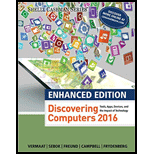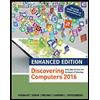
Concept explainers
Explanation of Solution
Steps to determine whether a website is safe:
Website owner should ensure the safety of its user, however unfortunately, some websites are not secure.
An unsafe website can steal user private information, send spam, and spread malware.
To protect website user and their sensitive personal information, it is vital to know that a website takes user’s safety seriously.
The following are the ways to determine whether a website is safe:
- Look for “https” in the web Uniform Resource Locator (URL).
- This infers the site is secure.
- The security is offered by the Secure Socket Layer (SSL) certificate.
- Check the website’s privacy policy.
- A website’s privacy policy must communicate clearly how user information is collected, protected, and used by the website.
- A privacy policy ensures that the website complying with the laws and thus, the website is safe.
- Find the website’s contact information.
- A website’s contact information ensures that the website is more trustworthy to users.
- Preferably, a safe website would clearly display a phone number, an email address, social media accounts, and a physical address if they have one.
- The contact information will not provide protection; however, they indicate that there is someone to reach the website if users need assistance.
- Verify website’s trust seal.
- If user sees an icon with words “Verified” or “Secure”, it is probably a trust seal.
- A trust seal typically denotes that a security partner is working with the website.
- This seal often indicates that the website has safety features and “https” security.
Steps to identify email spoofing and other spoofing:
The forgery of the e-mail header is called as email spoofing.
The message appears to be originated from somewhere or someone other than the original source.
The following are the steps to identify email spoofing and other spoofing:
- Inspect the email source code...
Explanation of Solution
List of protections used by organizations to safeguard users on the network:
List of protections used by organizations to safeguard users on the network are listed below:
- Firewalls.
- Proxy servers.
- Login authentication.
- Audit trails.
- Access control.
Firewalls:
- A firewall is a piece of hardware or a software program that restricts malicious threats from entering the computer and mobile devices.
- It can restrict communications to and from sources, a user does not permit.
- Some
operating system offers to build in firewalls. Be sure to turn on the firewall always. - To be effective and efficient, firewall must be configured appropriately and updated on a regular basis.
Proxy servers:
- A proxy server can obscure a user’s private Internet Protocol (IP) address.
- It can block the malicious traffic and specific websites.
- It can log the activities of a server.
Username and password:
- The most vital thing is not to practice the same username and password for all applications...
Trending nowThis is a popular solution!

Chapter 5 Solutions
Enhanced Discovering Computers 2017 (Shelly Cashman Series) (MindTap Course List)
 Enhanced Discovering Computers 2017 (Shelly Cashm...Computer ScienceISBN:9781305657458Author:Misty E. Vermaat, Susan L. Sebok, Steven M. Freund, Mark Frydenberg, Jennifer T. CampbellPublisher:Cengage Learning
Enhanced Discovering Computers 2017 (Shelly Cashm...Computer ScienceISBN:9781305657458Author:Misty E. Vermaat, Susan L. Sebok, Steven M. Freund, Mark Frydenberg, Jennifer T. CampbellPublisher:Cengage Learning
